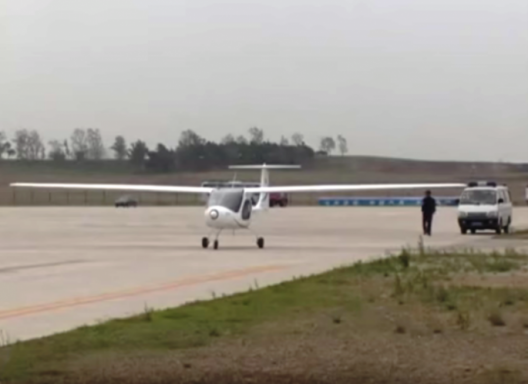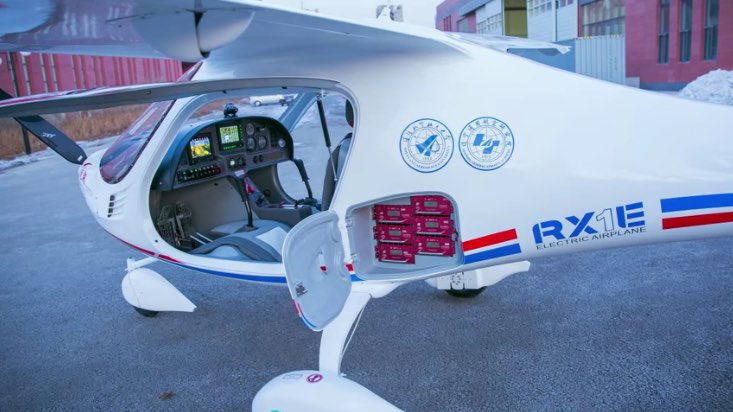China has seen Yuneec’s early entry into the electric aircraft field. The parent company is now making drones and camera gear in China, but its Greenwing International subsidiary in Cable, California appears to be defunct, according to Bill Lofton’s EV Hangar. Yuneec’s E430 two-seater and e-Spyder ultralight, all flown at the big AirVenture shows, will seemingly not come to market.
A craft similar to the E430, the RX1E Ruixiang, is ready to go into mass production, however. Developed by Shenyang Aerospace University in Shenyang City in China’s Liaoning Province, the long-winged two seater is the first electric aircraft certified by the Civil Aviation Administration of China (CAAC).

An early test flight of the RX1E. Note sailplane-like wings, great visibility
Certification was a major accomplishment, according to Yang Fengtian, chief designer of the airplane. “Unlike military aircraft and commercial jets, there are certain criteria that an electric plane must have before given permission to fly. The plane has to be light enough, and the batteries need to be efficient and reliable, and overall it has to be cost-effective to be mass produced.”
It’s just finished low-temperature flight tests, important in an electric airplane because of the reduced energy in batteries at lower temperatures. The factory, which has four RX1Es in service with more than 240 hours total flight time, is ready to build 20 more.
Developed by Liaoning Ruixiang General Aviation Co Ltd in northeast China, the RX1E could be used for pilot training, sightseeing and aerial photography.
The aircraft, made of carbon fiber composite, has all the advantages of electric aircraft, such as low operating cost, convenience, and no carbon emissions from the plane.
Since its initial test flights, the batteries have been improved to increase flight time per charge. The plane will stay aloft for 45 to 60 minutes at a maximum speed of 120 kilometers per hour (74 mph) after an hour and a half of charging. The overall design has remained relatively unchanged.
The RX1E is also similar to Pipistrel’s Alpha Electro, and has six Kokam battery packs that can be removed for recharging. This feature allows flight schools to have pre-charged packs ready to swap once a student has made a final landing.
Yang commented, “The RX1E will significantly push the development of China’s general aviation industry, because the bottlenecks facing the current general aviation field are not just airspace resources, but also the lack of low-cost planes like the RX1E,”
Gas2.org lists the specifications for the RX1E as follows.
- wingspan = 14.5 meters
- maximum cruising speed = 150 kilometers per hour (93 mph)
- maximum takeoff weight = 500 kilograms (1,100 pounds)
- maximum altitude = 3000 meters (9,840 feet)
- capital cost = 980,000 yuan (~$157,000)
- operational cost = 20 yuan ($3.20) per hour – that should attract some attention.
Thanks to Wayne Cook of the Sustainable Aviation Foundation board for alerting your editor to this story.


Comments 1
Author
Bill Lofton, of EVHangar.com, illuminates some points on the RX1E’s certification and production.
After some digging, I think the latest real news is http://en.people.cn/n/2015/1204/c90000-8985950.html which says the RX1E has production approval as of December 2015. That means that the RX1E’s airworthiness certificate from the Civil Aviation Administration of China in February 2015 http://www.chinadaily.com.cn/business/2015-02/07/content_19517256.htm didn’t mean that the RX1E had production approval at that time.
So the June 2015 “sale” of two RX1Es reported in spinoffs of the Shenyang Aerospace University announcement http://en.sau.edu.cn/other/show.asp?D_id=2010 was really more of a ceremony for student training and sale or transfer of two RX1E prototype airplanes before production would begin.
The good news is that apparently RX1Es can now be manufactured and sold in China and the manufacturer supposedly plans to build 20 this year and ramp up to 100 per year within 3 years. Maybe we’ll hear more from AERO Friedrichshafen in April.